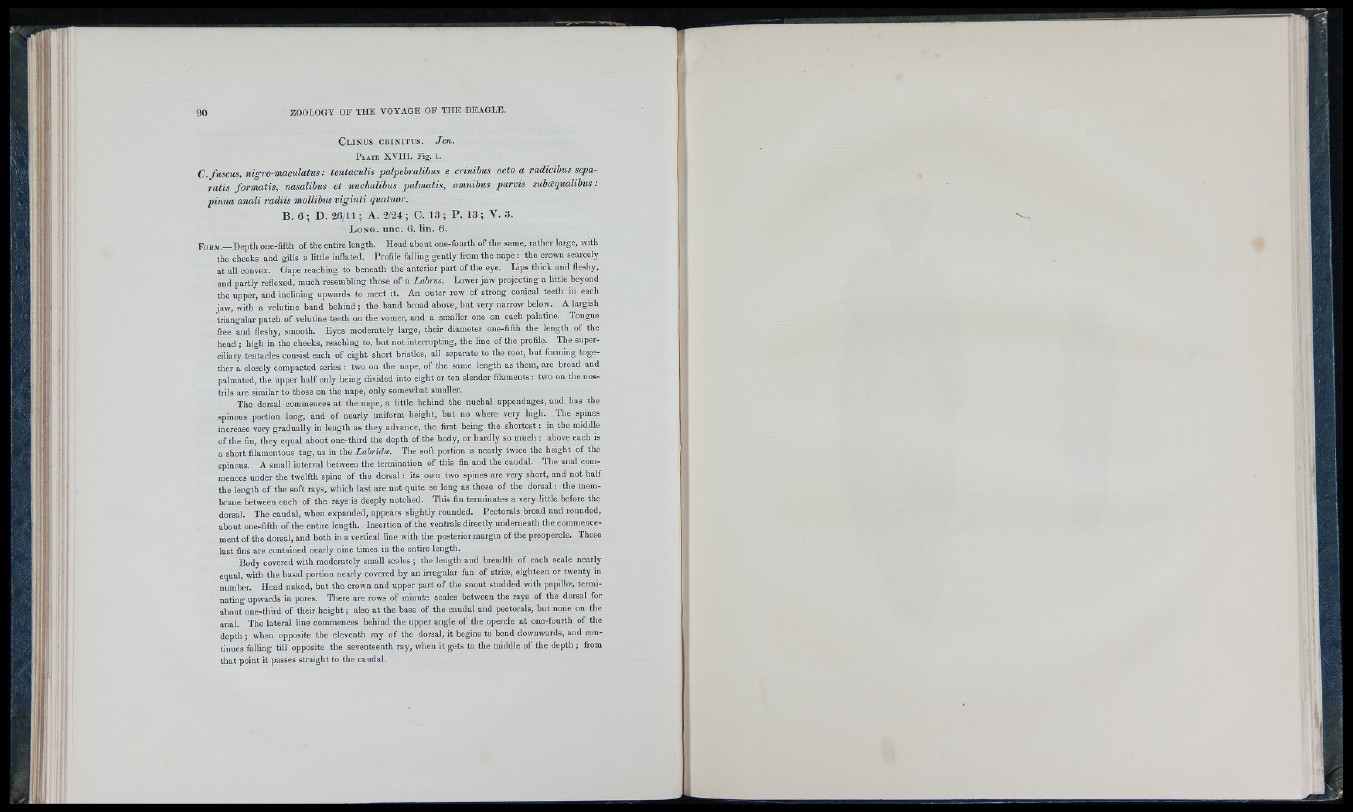
C l in u s c r in it u s . Jen.
P liT E X V III. Fig. I.
C. fuscus, nigro-maculatus : tentaculis palpebralibus e crinibus octo a radicibus sepa-
ratis formatis, nasalibus et nuclmlibus palmatis, omnibus parvis subcequalihus:
pinna anali radiis mollihus viginti quatuor.
B . 6 ; D . 26/11 ; A . 2/24 ; C . 13 ; P . 13 ; V . 3.
L o n g . u n c . 6 . lin . 6.
Form .— D epth one-flfth of the entire length. Head about one-fourth of the same, rather large, with
the cheeks and gills a litüe inflated. Profile falling gently from the nape ; the crown scarcely
a t all convex. Gape reaching to beneath the anterior part of the eye. Lips thick and fleshy,
and partly reflexed, much resembling those of a Labms. Lower jaw projecting a little beyond
the upper, and inclining upwards to meet it. An outer row of strong conleal teeth in each
jaw , with a velutine band behind ; the band broad above, b u t very narrow below. A largish
triangular patch of velutine teeth on the vomer, and a smaller one on each palatine. Tongue
free and fleshy, smooth. Eyes moderately large, their diameter one-fifth the length of the
head ; high in the cheeks, reaching to, but not interrupting, the line of the profile. The superciliary
tentacles consist each of eight short bristles, all separate to the root, but forming together
a closely compacted series : two on the nape, of the same length as them, are broad and
palmated, the upper h alf only being divided into eight or ten slender filaments ; two on the nostrils
are similar to those on the nape, only somewhat smaller.
Tlie dorsal commences at the nape, a little behind the nuchal appendages, and has the
spinous portion long, and of nearly uniform height, but no where very high. The spines
increase very gradually in length as they advance, the first being the shortest : in tile middle
of the fin, they equal about one-third the depth of the body, or hardly so much ; above each is
a short filamentous lag, as in the Labriioe. The soft portion is nearly twice the height of the
spinous. A small interval between the termination of this fln and the caudal. The anal commences
under the twelfth spine of the dorsal : its own two spines are very short, and not half
the length of the soft rays, which last are not quite so long as those of the dorsal : the membrane
between each of tlie rays is deeply notched. This fin terminates a very little before the
dorsal. The caudal, when expanded, appeals slightly rounded. Pectorals broad and rounded,
about one-fifth of the entire length. Insertion of the ventrals directly underneath the commencem
ent of the dorsal, and both in a vertical line with the posterior margin of the preopercle. These
last fins are contained nearly nine times in the entire length.
Body covered with moderately small scales ; the length and breadth of each scale nearly
equal, with the basal portion nearly covered by an irregular fan of striæ, eighteen or twenty in
number. H ead naked, but the crown and upper part o f the snout studded with papilloe, terminating
upwards in pores. There are rows of minute scales between the rays of the dorsal for
about one-third of their height ; also a t the base of the caudal and pectorals, but none on the
anal. The lateral line commences behind the upper angle of the opercle a t one-fourth of the
depth ; when opposite the eleventh ray of the dorsal, it begins to bend downwards, and continues
falling till opposite the seventeenth ray, when it gets to the middle of the depth ; from
that point it passes straight to the caudal.